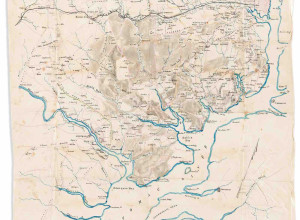Huntington Exhibition Commemorates Magna Carta’s 800th Anniversary

SAN MARINO, Calif.—In commemoration of the 800th anniversary of the signing of the Magna Carta, The Huntington Library, Art Collections, and Botanical Gardens will explore the origins and trace the establishment of Magna Carta and the rule of law with an exhibition drawn exclusively from its world-class holdings in medieval and modern British law, literature, and history, as well as materials of the 17th to 20th centuries drawn from its equally remarkable American collections. “Magna Carta: Law and Legend, 1215-2015” will be on view in the West Hall of the Library from June 13-Oct. 12, 2015.
The most comprehensive exhibition on the West Coast to honor the Magna Carta’s anniversary, “Magna Carta: Law and Legend” complements related celebrations being held this year by the British Library, the Library of Congress, and the American Bar Association. “Nearly a millennium of Anglo-American legal tradition is based on the fundamental propositions that no one, whether a monarch or other executive authority, is above the law, that legitimate governments are subject to the rule of law, and that all persons, whether subject or citizen, are entitled to due process and protection under the law,” said Vanessa Wilkie, William A. Moffett Curator of Medieval and British Historical Manuscripts and co-curator of the exhibition. On June 15, 1215, along the Thames River at a place called Runnymede, rebellious barons compelled King John to accept the Magna Carta, a “great charter” of liberties that subjugated the power of the monarch to the rule of law.
“As a peace treaty intended to ward off civil war, the original Magna Carta was a short-term failure, revoked later that summer,” said Mary Robertson, co-curator of the exhibit and Wilkie’s predecessor. “But it was remembered, revised, and reissued the following year and given permanent authoritative form in 1225 by King John’s son, King Henry III. Over the following centuries, many minor provisions faded into irrelevancy, but three of its key principles—that no one is above the law, that justice may not be sold, denied, or delayed, and that no man may be imprisoned or his property confiscated without due process of law—have continued to resonate down the centuries.”
The original document sealed at Runnymede has been lost, but multiple copies of it were made for distribution, and of these, only four now survive: two at the British Library, one at Salisbury Cathedral, and one at Lincoln Cathedral. The cornerstone of The Huntington’s exhibition is a rare preliminary 13th-century draft of the Magna Carta that was copied into a book of parliamentary statutes compiled nearly 80 years after King John granted the Great Charter.
“The Magna Carta was rediscovered and reinterpreted in the 17th century, and as its reputation grew, it provided inspiration for both common and constitutional law, helping to engender the English Bill of Rights in 1689, the U.S. Constitution in 1787 and its Bill of Rights in 1789, and the United Nations’ Universal Declaration of Human Rights in 1948,” said Wilkie. “Magna Carta: Law and Legend” will explore the changing interpretations of Magna Carta over time and on both sides of the Atlantic, as well as Magna Carta’s representation in popular culture, imagination, and myth. In addition, the exhibit will touch upon the demonization of King John as a narrative device to promote the rule of law,” said Wilkie.
Featuring manuscripts, rare books, images, and ephemera, “Magna Carta: Law and Legend” will provide Huntington visitors with a rare overview of eight centuries of law and history through the depth and breadth of The Huntington’s collections. Items on display will include a handsome 15th-century illuminated copy of English statutes, beginning with the Magna Carta; a 15th-century illuminated manuscript of the Brut Chronicle (the most popular history of England in the Middle Ages), which includes the history of King John’s reign; the playwright John Bale’s autograph manuscript of his play King Johan, circa 1538 and 1558-60; Lord Chancellor Ellesmere’s manuscript treatise on Magna Carta; early editions of Edward Coke’s and William Blackstone’s books on English law and the unwritten constitution; a first edition of Thomas Paine’s famous pamphlet Common Sense (1776); copies of the U.S. Constitution and the Bill of Rights; and 19th- and 20th- century political cartoons and ephemera illustrating the veneration of Magna Carta as the foundation of British liberties.
“With the presidential election cycle beginning to gear up, national debates relating to the rule of law, due process, habeas corpus, and other fundamental liberties are likely to arise, making the study and appreciation of key principles enshrined in Magna Carta more relevant than ever,” said Wilkie. “This exhibition will help visitors better understand the history of a document that has come to serve as a powerful symbol of law and justice in democratic societies around the world.”
The installation of “Magna Carta: Law and Legend” will be supplemented with modern media references to Magna Carta and the British Library’s “Magna Carta Online,” which includes an English translation of the original Latin text.
The Pasadena-based law firm Hahn & Hahn LLP is the exclusive corporate sponsor of the exhibition. The Robert F. Erburu Exhibition Endowment Fund will provide additional support.
Image: Rare draft of the Magna Carta, Laws & Statutes, England, 13th century. The Huntington Library, Art Collections, and Botanical Gardens.















